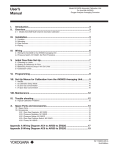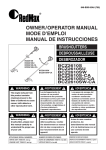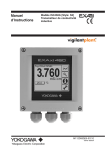Download Model EXAxt AV550G HART Protocol
Transcript
User’s Manual Model EXAxt AV550G HART Protocol IM 11M12D01-51E R IM 11M12D01-51E 2nd Edition i INTRODUCTION This is the HART Communicator manual for the EXAxt series of Model AV550G. This manual is described under the HART equipment that is ready to operate. When using the HART Protocol for the EXAxt AV550G, please refer to the following instruction manuals. n Special descriptions in this manual This manual describes the products and instruction manuals listed below. Products AV550G: Averaging converter Instruction manual AV550G Instruction Manual: IM 11M12D01-01E n Drawings in this manual Drawings in this manual may be emphasized, abbreviated or partially omitted for easier explanation. Screen images in this instruction manual are drawings to give you an idea of functions and operation; they may be slightly different from actual screen displays. n Other items The contents of this manual are subject to change without prior notice. Media No. IM 11M12D01-51E (CD) 2nd Edition : Dec. 2010 (YK) All Rights Reserved Copyright © 2005, Yokogawa Electric Corporation IM 11M12D01-51E ii After-sales Warranty Do not modify the product. During the warranty period, for repair under warranty carry or send the local sales representative or service office. Yokogawa will replace or repair anyproduct to the damaged parts and return the product to you. Before returning a product for repair under warranty, provide us with the model name and serial number and a description of the problem. Any diagrams or data explaining the problem would also be appreciated. If we replace the product with a new one, we won’t provide you with a repair report. Yokogawa warrants the product for the period stated in the pre-purchase quotation. Yokogawa shall conduct defined warranty service based on its standard. When the customer site is located outside of the service area, a fee for dispatching the maintenance engineer will be charged to the customer. In the following cases, customer will be charged repair fee regardless of warranty eriod. • Failure of components which are out of scope of warranty stated in instruction manual. • Failure caused by usage of software, hardware or auxiliary equipment, which Yokogawa Electric did not supply. • Failure due to improper or insufficient maintenance by user. • Failure due to modification, misuse or outside-of-specifications operation which Yokogawa does not authorize. • Failure due to power supply (voltage, frequency) being outside specifications or abnormal. • Failure caused by any usage out of scope of recommended usage. • Any damage from fire, earthquake, storms and floods, lightning, disturbances, riots, warfare, radiation and other natural changes. Yokogawa does not warrant conformance with the specific application at the user site. Yokogawa will not bear direct/indirect responsibility for damage due to a specific application. Yokogawa Electric will not bear responsibility when the user configures the product into systems or resells the product. Maintenance service and supplying repair parts will be covered for five years after the production ends. For repair for this product, please contact the nearest sales office cribed in this instruction manual. IM 11M12D01-51E i <CONTENTS> Model EXAxt AV550G HART Protocol IM 11M12D01-51E 2nd Edition CONTENTS INTRODUCTION........................................................................................................i u After-sales Warranty . .........................................................................................ii 1. Operation via HART Communicator....................................................... 1-1 1.1 2. 3. 1.1.1 Interconnection between AV550G and HART Communicator........... 1-1 1.1.2 Communication Line Requirements ..................................................1-1 Basic Operation of the HART Communicator (Model 275)................... 2-1 2.1 Keys and Functions........................................................................................... 2-1 2.2 Display................................................................................................................. 2-3 2.3 Calling Up Menu Addresses............................................................................. 2-4 2.4 Entering, Setting and Sending Data................................................................ 2-4 Parameters................................................................................................. 3-1 3.1 Menu Tree........................................................................................................... 3-1 3.2 Setting Parameters............................................................................................ 3-7 3.2.1 Burst Mode.......................................................................................... 3-7 3.2.2 Multidrop Mode................................................................................... 3-8 3.2.3 Write Protection................................................................................ 3-10 3.3 Calibration........................................................................................................ 3-14 3.4 Indication Check.............................................................................................. 3-15 3.5 Blow Back ........................................................................................................ 3-16 3.6 Self-Diagnostics .............................................................................................. 3-17 3.7 4. Conditions of Communication Line................................................................. 1-1 3.6.1 Control Card Self-Diagnostics.......................................................... 3-17 3.6.2 Channel Card Self-Diagnostics........................................................ 3-18 Status Check ................................................................................................... 3-20 Maintenance............................................................................................... 4-1 Revision Information................................................................................................i IM 11M12D01-51E ii IM 11M12D01-51E <CONTENTS> 1-1 <1. OPERATION VIA HART COMMUNICATOR> 1. Operation via HART Communicator 1.1 Conditions of Communication Line 1.1.1 Interconnection between AV550G and HART Communicator The HART Communicator can interface with the AV550G from the control room, the AV550G site, or any other wiring termination point in the loop, provided there is a minimum load resistance of 250Ω between the connection and the receiving instrument. To communicate, it must be connected in parallel with the AV550G, the connections are non-polarized. Figure 1.1 illustrates the wiring connections for direct interface at the AV550G site. The HART Communicator can be used for remote access from any terminal strip as well. 4 to 20 mA DC signal line with superimposed HART AC signal Relaying terminals Ave-a + + AV550G Control room Terminal board – Ave-a Receiving instrument load resistance: 250Ω to 550Ω HART Communicator Model 275 HART Communicator Model 275 HART Communicator Model 275 F34.ai Figure 1.1 Interconnection Diagram 1.1.2 Communication Line Requirements Specifications for Communication Line: Load resistance: 250 to 550Ω (including cable resistance) When multidrop mode, see Figure 1.2. Minimum cable size: 24 AWG, (0.51 mm diameter) Cable type: Single pair shielded or multiple pair with overall shield Maximum twisted-pair length: 2,000 m Maximum multiple twisted-pair length: 1,000 m Use the following formula to determine cable length for a specific application; L= 65 x 10 (R x C) 6 (Cf + 10,000) C where: L = length in feet or meters R = resistance in ohms, current sense resistance C = cable capacitance in pF/ft or pF/m Cf = 50,000 pF IM 11M12D01-51E 1-2 <1. OPERATION VIA HART COMMUNICATOR> 800 Outside of range 600 Load Resistance (Ω) Range of acceptable load resistance values 400 200 Outside of range 0 1 2 3 4 5 6 7 8 9 10 11 12 13 14 15 Number of connected field devices F010201.ai Figure 1.2 Load Resistance and Number of Devices in Multidrop Mode IM 11M12D01-51E 2-1 <2. Basic Operation of the HART Communicator (Model 275)> 2. Basic Operation of the HART Communicator (Model 275) 2.1 Keys and Functions Communication Cable LCD (Liquid crystal display) (21 charactersx8 lines) Function keys Functions of the keys are indicated on the display. Move the inverse video bar (cursor) on the display to select the desired item. Hot Key Call up Hot Key Menu as follows: 1. Ave-a O2 display 2. Ch O2 display 3. Chng Wrt Protect Power ON/OFF 1. Change the display contents. 2. Move the position where a number or character is to be entered. Example Pressing calls up the display corresponding to the item pointed with the cursor. Pressing returns to the previous display. (See 2.3 Calling up Menu Address.) Alphanumeric keys 1. Enter numbers and characters. 2. Select the desired menu item with the corresponding number. (See 2.4 Entering, Setting and Sending Data) Shift keys Use to enter alphabetic characters. Example Pressing single key enters the number. Pressing the key with shift key enters the alphabetic character. (Press) (ENTER) To enter “ 7 ”, To enter “ C ”, ABC 7 ABC 7 ‘7’ ‘C’ F020101.ai Figure 2.1 HART Communicator IM 11M12D01-51E 2-2 <2. Basic Operation of the HART Communicator (Model 275)> 2.2 Display The HART Communicator automatically searches for AV550G on the 4 to 20 mA loop when it is turned on. When the HART Communicator is connected to a AV550G, it displays “Online” menu as shown below. (If AV550G is not found, the communicator displays the message “No Device Found. Press OK....” Press the OK ‘F4’ function key and the main menu appears. Please retry after confirming the connection with the AV550G.) Tag (8 Characters) Manufacturer’s Field Device Type Code <2> <3> <4> appears when the voltage level of the battery is low AV550G: Online 1 2 3 4 Device setup PV PV URV PV LRV SAVE <5> <1> 21.64 % 21 % 0% Pressing one of the SHIFT keys makes the arrow mark orresponding to the pressed key appear. The highlighting cursor Function keys F020201.ai Figure 2.2 Display <1> appears and flashes during communication between the HART Communicator and the AV550G. In Burst mode*, appears. <2> The current display menu title appears. <3> Each item in menu of <2> appears. <4> and/or appear when the items are scrolled out of the display. <5> On any given menu, the label appearing above a function key indicates the function of that key in the current menu. Note: (*) Refer to “3.2.1 Burst Mode”. IM 11M12D01-51E 2-3 <2. Basic Operation of the HART Communicator (Model 275)> Function Key Labels F1 F2 F3 F4 HELP access on-line help ON/OFF activates or deactivates a binary variable ABORT terminate current task OK acknowledge information on screen RETRY try to reestablish communication DEL delete current character or Hot Key Menu item ESC leave value unchanged ENTER accept user-entered data EXIT leave the current menu SEND send data to device, or mark data to send QUIT terminate session because of a communication error NEXT leave the current menu YES answer to yes/no question PGUP move up one help screen PGDN move down one help screen NO answer to yes/no question ALL include current Hot Key item on Hot Key Menu for all devices PREV go to previous message in a list of messages NEXT go to next message in the list of messages SKIP do not mark variable to be sent in off-line configuration HOME go to the top menu in the device description ONE include Hot Key item for one device EDIT SAVE save information edit a variable value to communicator SEND ADD send data to add current item device, or mark to Hot Key data to send Menu BACK go back to menu from which HOME was pressed F0204.ai 2.3 Calling Up Menu Addresses 3.1 Menu Tree shows the configuration of Online Menu which is needed for the operation with HART Communicator. The desired item can be displayed with ease by understanding the menu configuration. When the HART Communicator is connected to the AV550G, “Online” menu will be displayed after the power is turned on (See Figure 2.2). Call up the desired item as follows: Key operation There are two ways to select a desired menu item. 1. Use the or key to select the desired item, and then press the key. 2. Press the number key corresponding to the desired item. • To return to the previous display, press the key. If EXIT, ESC and ABORT are displayed, press the desired function Key. Example: Call up the “Tag” to change the tag number. Check where “Tag” is located in the menu tree. Then, call up “Tag” on the display according to the menu tree. IM 11M12D01-51E 2-4 <2. Basic Operation of the HART Communicator (Model 275)> AV550G: Tag Process variables Diag / Service Basic setup Detailed setup Review Device setup PV PV URV PV LRV 1 Tag PV Unit Xfer fnctn ESC ENTER Operation Display 1 at left appears when the S HART communicator is turned on. or STU T 1 U Select " Device set up" . 1 AV550G: Online Device setup PV PV URV PV LRV DEL F020301.ai Display 1 2 3 4 HELP 21.64 % 21 % 0% SAVE 2 AV550G: Device setup 1 2 3 4 5 3 Process variables Diag/Service Basic setup Detailed setup Review SAVE HOME or YZ/ 3 3 AV550G: Basic setup 1 Tag 2 PV Unit 3 Xfer fnctn Linear Y Z / or % . ". Select " Basic setup x2 STU 1 1 S T Select " Tag " . U HELP SAVE HOME 4 AV550G: Tag HELP IM 11M12D01-51E DEL The display for Tag setting appears. (The default value of "Tag " is blank.) ESC ENTER F020302-1.ai 2.4 <2. Basic Operation of the HART Communicator (Model 275)> 2-5 Entering, Setting and Sending Data The data, which are entered with the keys, are set in the HART Communicator by pressing ENTER (F4). Then, by pressing SEND (F2), the data are sent to the AV550G. Note that the data are not set in the AV550G if SEND (F2) is not pressed. All the data set with the HART Communicator are held in memory unless power is turned off, so all data can be sent to the AV550G in one burst. Operation Entering data on the “Tag” setting display. On alphabetic characters, only capital letters can be used for setting Tag No. with HART Communicator. Example: Set " FIC-1A ". 5. Tag F020401.ai Call up “Tag” setting display. 1. Device setup ---> 3.basic setup ---> 5.Tag AV550G: Tag HELP DEL ESC ENTER Fig-2001.ai On the setting display shown above, enter the data as follows: Character to be entered Operation Display F DEF 8 F I GHI 9 FI C ABC 7 FIC - *:+ – FIC- 1 STU 1 FIC-1 A ABC 7 FIC-1A F020403.ai IM 11M12D01-51E 2-6 1 <2. Basic Operation of the HART Communicator (Model 275)> AV550G: Tag Display Operation F4 FIC-1A HELP (ENTER) DEL ESC ENTER 2 AV550G: Basic setup 1 Tag FIC-1A 2 PV Unit 3 Xfer fnctn Linear HELP SEND F2 % 1 Tag FIC-1A 2 PV Unit 3 Xfer fnctn Linear SAVE (SEND) Press SEND (F2) to send the data to the AV550G. is flashing during communication. HOME 3 AV550G:FIC-1A Basic setup HELP Press ENTER (F4) to set the data in the HART Communicator after entering the data. % SENDD label changed to SAVE label, SEN and the transmission is completed. Press HOME (F3) , and return "Online Menu". HOME F020404.ai IM 11M12D01-51E <3. Parameters> 3. Parameters 3.1 Menu Tree 3-1 Online Menu 1 Device setup 2 PV 1 Process variables 1 PV 2 PV %rnge 3 PV URV 3 PV AO 4 PV LRV 4 Ave O2 1 Ave-a O2 2 Ave-b O2 3 Ave-c O2 5 Ch O2 1 Ch1 O2 2 Ch2 O2 3 Ch3 O2 4 Ch4 O2 5 Ch5 O2 6 Ch6 O2 7 Ch7 O2 8 Ch8 O2 6 Ave statistics 1 Ave-a statistics 2 Ave-b statistics 3 Ave-c statistics 7 Ch statistics 1 Ch1 statistics 2 Ch2 statistics 3 Ch3 statistics 4 Ch4 statistics 5 Ch5 statistics 6 Ch6 statistics 7 Ch7 statistics continued continued on the next page. on the next page. 8 Ch8 statistics T3001.ai IM 11M12D01-51E 3-2 <3. Parameters> Online Menu 1 Device setup 2 PV 1 Process variables 8 Indicators 1 Status group 1 Error Hi Hi alarm 3 PV URV Hi alarm 4 PV LRV Lo alarm Lo Lo alarm Maintenance Calibration Range change 2 Status group 2 Warm up Cal gas low Indication check Blow back Proc gas alarm Third gas Cal alarm Inside temp 1 Span gas ratio 2 Diag/Service 1 Loop test 2 Zero gas ratio 2 Calibration 3 Response time 3 Indication check 4 Cell robustness 4 Blow back 5 Cell resistance 5 Calib log 1 Ch1 calib log 6 Next cal date 2 Ch2 calib log (ditto) 3 Ch3 calib log (ditto) 4 Ch4 calib log (ditto) continued on the next page. 5 Ch5 calib log (ditto) 6 Ch6 calib log (ditto) 7 Ch7 calib log (ditto) 8 Ch8 calib log (ditto) IM 11M12D01-51E T3002.ai 3-3 <3. Parameters> Online Menu 1 Device setup 2 PV 3 Basic setup 1 Tag 3 PV URV 2 PV Unit 4 PV LRV 3 Xfer fnctn 4 Detailed setup 1 Control 1 Error Ctrl card 2 Alarm Ave-a oxygen Ave-b oxygen Ave-c oxygen Process gas Cal gas press lo Inside temp continued continued on the next page. on the next page. T3003.ai IM 11M12D01-51E 3-4 <3. Parameters> Online Menu 1 Device setup 2 PV 4 Detailed setup 2 Channels 1 Ch1 detailed setup 3 PV URV 2 Ch2 detailed setup (ditto) 4 PV LRV 3 Ch3 detailed setup (ditto) 4 Ch4 detailed setup (ditto) 5 Ch5 detailed setup (ditto) 6 Ch6 detailed setup (ditto) 7 Ch7 detailed setup (ditto) continued continued on the next page. on the next page. 1 Ch1 sts 2 Sensors 8 Ch8 detailed setup (ditto) 1 Cell mV 2 Cell temp 3 CJ temp 4 TC volt 5 CJ val 6 Heater duty 3 Error Cell voltage Heater temp Ch card Card comm 4 Alarm Oxygen Zero conc ratio Span conc ratio Cal time over CJ temp Asymmetry alarm T3004.ai IM 11M12D01-51E 3-5 <3. Parameters> Online Menu 1 Device setup 2 PV 4 Detailed setup 3 Channel status 1 Ch1 sts 3 PV URV 2 Ch2 sts 4 PV LRV 3 Ch3 sts 4 Ch4 sts 5 Ch5 sts 6 Ch6 sts 7 Ch7 sts 8 Ch8 sts continued on the next page. 4 Output condition 1 HART output 1 Poll addr 2 Num req preams 3 Burst mode 4 Burst option 5 Device information 1 Distributor 2 Model 3 Dev id 4 Tag 5 Date 1 Universal rev 6 Write protect 2 Fld dev rev 7 Descriptor 3 Control card 8 Message 4 Ch1 9 Final asmbly num 5 Ch2 Revision #'s 6 Ch3 7 Ch4 8 Ch5 9 Ch6 Ch7 Ch8 Loader T3005.ai IM 11M12D01-51E 3-6 <3. Parameters> Online Menu 1 Model 1 Device setup 5 Review 2 PV 2 Distributor 3 PV URV 3 PV Snsr unit 4 PV LRV 4 PV USL 5 PV LSL 6 PV Min span 7 PV % rnge 8 Xfer fnctn 9 PV Rnge unit PV URV PV LRV PV AO PV AO Alrm type Snsr s/n Write protect Manufacturer Dev id Tag Descriptor Message Date Universal rev Fld dev rev Software rev Burst mode Burst option Poll addr T3006.ai IM 11M12D01-51E Num req preams 3.2 3-7 <3. Parameters> Setting Parameters 3.2.1 Burst Mode The AV550G continuously sends the data stored in it when burst mode is set “On”. Either one of measured value, % output value, or 4 to 20 mA output value can be selected and sent. The data is sent periodically at 75 ms intervals as a digital signal when the AV550G is set in burst mode. Therefore, communication by the HART simultaneous communicator is also possible. Setting of Burst Mode Call up “Burst option” display. 1.Device setup ---> 4.Detailed setup ---> 4.Output condition ---> 1.HART output ---> 4.Burst option Display Operation AV550G: Burst option % range/current Process vars/crnt HELP ESC (ENTER) ENTER Call up" Burst mode" display. 3.HART output 3.Burst mode 1 AV550G: Burst mode Off F4 off on Set " On" and press ENTER (F4). (ENTER) ESC 2 AV550G: HART output 1 2 3 4 Set data to be sent. Measured value (PV) % output value (% range/current) 4 to 20 mA output value (Process vars /crnt) F4 ******** PV Poll addr Num req preams Burst mode Burst option HELP ENTER 0 5 On PV F2 Press SEND (F2). (SEND) SEND HOME F030209-1.ai IM 11M12D01-51E 3-8 <3. Parameters> 3.2.2 Multidrop Mode Field devices in multidrop mode refer to the connection of several field devices on a single communication line. Up to 15 field devices can be connected when set in multidrop mode. To activate multidrop communication, each field device address must be changed to a unique number in the range 1 to 15. This change deactivates the 4 to 20mA output and changes it to 4mA. Setting of Multidrop Mode Call up “Poll addr” display. 1.Device setup ---> 4.Detailed setup ---> 4.Output condition ---> 1.HART output --->1.Poll addr AV550G: Poll addr 0 0 HELP Operation Display "1" F4 F2 (ENTER) (SEND) DEL ESC Set the polling address (a number from 1 to 15) and press ENTER (F4) . Then Press SEND (F2). ENTER F030210-1.ai Call up “Auto Poll” display. HART output ---> Online Menu ---> Main Menu ---> 4.Utility ---> 1.Configure Communication ---> 1.Polling Display Operation 1 AV550G: HART output 1 2 3 4 Poll addr Num req preams Burst mode Burst option 1 5 On PV F3 Return "Online Menu " with HOME (F3). (HOME) HELP SEND HOME 2 AV550G: Online 1 2 3 4 Device setup PV PV URV PV LRV Return to " Main Menu " with a " previous" key. 21.64 % 21 % 0% SAVE 3 HART Communicator 1 2 3 4 Offline Online Frequency Device Utility JLK 4 Select " Utility " . F030211-1.ai IM 11M12D01-51E 3-9 <3. Parameters> 4 HART Communicator Utility 1 2 3 4 5 Select " Configure Communication. " Configure Communic System Information Listen for PC Storage Location Simulation 5 HART Communicator Configure Communica Select " Polling " . 1 Polling 2 Contrast 3 Off Time 4 Ignore diagnostics 5 Delete Configs HELP 6 HART Communicator Polling Ask Before Polling Never Poll Ask Before Polling Always poll Digital poll HELP ESC ENTER F4 x3 Select " Digital Poll " and press ENTER (F4). (ENTER) F030212-1.ai NOTE 1. If “Polling” is set to “Never Poll” after the address is set, “Online Menu” cannot be called up and displayed. Be sure to set “Polling” to “Digital Poll” after setting the polling address. 2. When the same polling address is set for two or more field devices in multidrop mode, communication with those field devices is disabled. Example: Communication when set in the multidrop mode. Display 1 HART Communicator Operation Online (1) The HART Communicator searches for field devices is set in multidrop mode when the HART Communicator is turned on. When a HART Communicator is connected to a field device, its tag will be displayed (display 1). 1 1: ZIA-01A 2 2: ZIA-02Arm 2 AV550G: ZIA-01A Online 1 2 3 4 Device setup PV PV URV PV LRV 21.64 % 21 % 0% (2) Select desired field device. After that, normal communication with the selected field device is possible. However, the communication speed is slow in this case (display 2). SAVE BACK 3 HART Communicator 1 2 3 4 Offline Online Frequency Device Utility (3) To communicate with another field device, call up display 3 , and select "Online". (4) Display1 will appear. Repeat the above operation. F030213-1.ai IM 11M12D01-51E 3-10 <3. Parameters> Releasing from Multidrop Mode First, call up the “Poll addr” display, and set the address to 0. Second, call up the “Polling” display, and set “Never Poll”. If the above releasing method is carried out in the reverse order “Online Menu” can not be called up. NOTE 3.2.3 Software Write Protect AV550G configured data is saved by the write protect function. Write protect status is set to YES when 8 alphanumerics are entered in the New password field and transferred to the AV550G. In write protect YES status, the averaging converter AV550G does not accept parameter changes. When the 8 alphanumeric string entered in the New password field is also entered in the Enable write field and transferred to the averaging converter, it will be possible to change averaging converter parameters during a 10 minute period. To change the averaging converter from write protect YES status back to write protect NO status, enter 8 spaces in the New password field after write protect has been released using enable write. Setting Password Example: Set the password to 1234 Call up “Chng Wrt Protect” display. Hot key ---> 3.Chng Wrt Protect 1 Display AV550G: Chng Wrt Protect 1 2 3 4 Write protect Enable wrt 10min New password Software seal Keep Operation No Select the " New password" . YZ/ 3 HELP SAVE 2 AV550G: Enter new password to change state of write protect: ' 1 2 3 4' 3 ABORT ENTER AV550G: Re-enter new password within 30 seconds:2 "1 2 3 4" 1234 Reenter "1234" and press ENTER (F4) within 30 seconds. ABORT ENTER 4 AV550G: It changed the state of protection related password. F4 (OK) OK IM 11M12D01-51E F4 (ENTER) DEL Set " 1234 " and press ENTER (F4) . (ENTER) 1234 DEL F4 F030215-1.ai <3. Parameters> 5 AV550G: Chng Wrt Protect 1 2 3 4 Write protect Enable wrt 10min New password Software seal Keep 3-11 Yes SAVE F030216-1.ai IM 11M12D01-51E 3-12 <3. Parameters> Changing Password Example: To change the password from 1234 to 6789A Call up “Chng Wrt Protect” display. Hot key ---> 3.Chng Wrt Protect 1 Display AV550G: Chng wrt Protect 1 Write protect 2 Enable wrt 10min 3 New password 4 Software seal Keep Operation No Select the " Enable wrt 10min" . VWX 2 SAVE 2 AV550G: Enter current password to enable to write for 10 minutes: 1234 DEL “1 2 3 4” ' Set the old password " 1234 " and press ENTER (F4). (ENTER) ABORT ENTER 3 AV550G: Released the write protection for 10 minutes. ABORT (OK) OK If you want to release completely, you have to change password to all of spaces. ABORT 5 AV550G: Chng Wrt Protect Write protect Enable wrt 10min New password Software seal Keep Press OK (F4). F4 4 AV550G: 1 2 3 4 F4 Press OK (F4). F4 (OK) OK Yes Select the " New password". YZ/ 3 SAVE 6 AV550G: Enter new passward to change state of write protect: "6789A" Set new password " 6789A " and press ENTER (F4). (ENTER) 6789A DEL ABORT ENTER 7 AV550G: Re-enter new password within 30 seconds: 6789A "6789A" F4 (ENTER) DEL IM 11M12D01-51E F4 ABORT ENTER Reenter new password " 6789A " and press ENTER (F4). F030218-1.ai 3-13 <3. Parameters> 8 AV550G: It changed the state of protection related password. F4 (OK) OK NOTE Press OK (F4). F030219-1.ai 1. Enable wrt 10 min releases write protect status for 10 minutes. While write protect status is released, enter a new password in the New Password field. It will not be possible to set a new password when 10 minutes have elapsed. 2. To release write protect status completely, enter 8 spaces in the New Password field according to the instructions given in Changing the Password. This causes write protect status to change from YES to NO. “Master password” and “Software Lock” If you forget the password that has been registered, it is possible to release the mode for 10 minutes by using a master password. Enter YOKOGAWA to release Write protect status for 10 minutes. If this master password is used, the status shown in the parameter “Software seal” is changed from “Keep” to “Break” Press Hot key and select “2 Wrt protect menu”. Current status is shown in “4 Software seal”. This status will be reverted from “Break” to “Keep” by registering a new password. IM 11M12D01-51E 3-14 <3. Parameters> 3.3 Calibration Here we explain how to excute Semi-Auto Calibration using HART communications. This requires the AV550G Calibration mode to have been set to Semi-Auto or Auto. For further details, refer to “Section 9. Calibration” in the AV550G Instruction Manual. NOTE Calibration-related parameters can not be set remotely using HART communication. Calibration can not be canceled using HART communication. Call up “Calibration” display. 1. Device setup ---> 2. Diag/Service ---> 3. Calibration 1 AV550G: Display Operation Select channel. 1 2 3 4 5 Ch1 Ch2 Ch3 Ch4 Ch5 STU 1 ABORT ENTER 2 AV550G: You select Ch1. Do you want to execute semi-auto calibration? ABORT 3 AV550G: Diag/Service 1 2 3 4 5 Loop test Calibration Indication check Blow back Calib log HELP IM 11M12D01-51E Select Channel to be calibrated (Ch1 in this example). SAVE HOME F4 Confirm that you want to execute calibration (OK) ON Calibration is started using parameters (Cal. Time, Hold Time) set in the AV550G F030301-1.ai 3.4 3-15 <3. Parameters> Indication Check Here we explain how to excute a Semi-Auto Indication check using HART communications. This requires the AV550G Indication check mode to have been set to Semi-Auto or Auto. For further details, refer to “Section 10. Indication Check” in the AV550G Instruction Manual. NOTE Indication-Check-related parameters can not be set remotely using HART communication. Indication Check can not be canceled using HART communication. Call up “Indication check” display. 1. Device setup ---> 2. Diag/Service ---> 3. Indication check 1 Display 1 Ch1 2 Ch2 3 Ch3 4 Ch4 5 Ch5 2 STU 1 AV550G: You select Ch1. Do you want to execute semi-auto indication check? AV550G: Diag/Service Select Channel for Indication Check (Ch1 in this example). ABORT ENTER ABORT 3 Operation AV550G: Select channel. 1 Loop test 2 Calibration 3 Indication check 4 Blow back 5 Calib log HELP SAVE HOME F4 Confirm that you want to execute Indication Check (OK) ON Indication Check is started using parameters (Check Time, Hold Time) set in the AV550G F030401-1.ai IM 11M12D01-51E 3-16 <3. Parameters> 3.5 Blow Back Here we explain how to excute a Semi-Auto Blow Back using HART communications. This requires the AV550G Blow back mode to have been set to Semi-Auto or Auto. For further details, refer to “Section 10.5 Blow Back” in the AV550G Instruction Manual. NOTE Blow-Back-related parameters can not be set remotely using HART communication. Blow Back can not be canceled using HART communication. Call up “Blow back” display. 1. Device setup ---> 2. Diag/Service ---> 4. Blow back 1 AV550G: Display Operation Do you want to execute blow back? F4 Confirm that you want to execute Blow Back (OK) ABORT 2 AV550G: Diag/Service 1 Loop test 2 Calibration 3 Indication check 4 Blow back 5 Calib log HELP SAVE HOME IM 11M12D01-51E ON Blow Back is started using parameters (Blow Back Time, Hold Time) set in the AV550G F030501-1.ai 3.6 3-17 <3. Parameters> Self-Diagnostics Here we explain how to check Error or Alarm messages from the AV550G using a HART Communicator. The table below shows the correspondence between error and alarm messages displayed on the HART Communicator and corresponding error and alarm messages in the AV550G. For more details about these error and alarm messages, and troubleshooting procedures, refer to “Section 12. Troubleshooting” in the AV550G Instruction Manual. 3.6.1 Control Card Self-Diagnostics Call up “Detailed setup” display. 1. Device setup ---> 4. Detailed setup 1 Display Operation AV550G: Detailed setup 1 2 3 4 5 STU 1 Control Channels Channel status Output condition Device information SAVE HOME 2 AV550G: Control STU 1 1 Error 2 Alarm SAVE 3 Select “ Control ” Select “ Error ” HOME AV550G: Error Ctrl card OFF If OFF is displayed (at right) then there are no errors. Revert to Error/Alarm screen. HELP 4 ON SAVE HOME AV550G: Control Select “ Alarm ” 1 Error 2 Alarm 2 SAVE 5 AV550G: Alarm Ave-a oxygen Ave-b oxygen Ave-c oxygen Process gas Cal gas press lo HELP HOME ON OFF OFF OFF OFF EXIT If OFF is displayed (at right) then there are no alarms. In the display at left, an Ave-a Oxygen Concentration Alarm has occurred. F030601-1.ai IM 11M12D01-51E 3-18 <3. Parameters> 3.6.2 Channel Card Self-Diagnostics Call up “Detailed setup” display. 1. Device setup ---> 4. Detailed setup Display Operation 1 AV550G: Detailed setup 1 2 3 4 5 VWX 2 Control Channels Channel status Output condition Device information SEND HOME 2 AV550G: Channels 1 2 3 4 5 3 STU 1 Ch1 detailed setup Ch2 detailed setup Ch3 detailed setup Ch4 detailed setup Ch5 detailed setup SAVE HOME AV550G: Ch1 detailed setup 1 2 3 4 YZ/ 3 Ch1 status Sensors Error Alarm SEND Error Cell voltage Heater temp Ch card Card comm AV550G: Ch1 detailed setup Revert to Error/Alarm screen. JKL 4 Ch1 status Sensors Error Alarm SEND Oxygen Zero conc ratio Span conc ratio Cal time over CJ temp 4 Alarm HELP Select “ Alarm ” HOME 6 AV550G: Alarm Select “ Error ” If OFF is displayed (at right) then there are no errors. In this example, a “ Heater temp ” alarm has occurred. OFF ON OFF OFF EXIT 1 2 3 4 Select “ Ch1 detailed setup” (this example shows how to display Self-Diagnostics for Channel 1). HOME 4 AV550G: 5 Select “ Channels ” ON OFF OFF OFF OFF EXIT If OFF is displayed (at right) then there are no alarms. In the display at left, an Oxygen concentration alarm has occurred. F030701-1.ai IM 11M12D01-51E <3. Parameters> 3-19 Channel card Control card Table3.1 AV550G Alarms and Errors displayed on HART Communicator HART Communicator Display Ctrl card Ave-a oxygen Ave-b oxygen Ave-c oxygen Process gas Cal gas press lo Inside temp Cell voltage Heater temp Ch card Card comm. Oxygen Zero conc. ratio Span conc. ratio Cal time over CJ temp Asymmetry alarm Explanation Control card abnormality Ave-a oxygen concentration outside alarm limits Ave-b oxygen concentration outside alarm limits Ave-c oxygen concentration outside alarm limits Process gas alarm contact signal received by AV550G Cal gas press lo alarm contact signal received by AV550G AV550G case internal temperature over alarm limit Cell emf abnormal Heater temperature abnormal Channel card abnormality detected Communications between control card and channel card abnormal Channel oxygen concentration outside alarm limits Zero correction factor outside normal range Span correction factor outside normal range Cell emf didn't stabilize during calibration interval Cold (reference) junction temp. outside normal range Abnormal change in asymmetry correction factor AV550G display Error 4 Alarm 1 Alarm 6 Alarm 7 Alarm 9 Error 1 Error 2 Error 3 Error 5 Alarm 1 Alarm 2 Alarm 3 Alarm 4 Alarm 5 Alarm 8 T0301.ai IM 11M12D01-51E 3-20 <3. Parameters> 3.7 Status Check You can check Channel Card Status using the HART Communicator. The meanings of these status indications are displayed in the table below. Call up “Detailed setup” display. 1. Device setup ---> 4. Detailed setup Display 1 AV550G: Detailed setup 1 2 3 4 5 2 Control Channels Channel status Output condition Device information SAVE HOME AV550G: Channel status 1 2 3 4 5 Ch1 Ch2 Ch3 Ch4 Ch5 sts Measuring sts Disable sts Measuring sts Error sts None SAVE HOME Operation YZ/ 3 Select “ Channel status” In the display example at left, Channel 2 is Disabled, Channel 4 is in Error status, and Channel 5 is Not Installed. You can scroll the screen to display status of channels 6 and later. F030801-1.ai Table 3.2 HART Communicator Display and Channel Card Status HART Communicator status display None Disable Warm up Measuring Blow back Cal Ind. check Error Proc gas Channel card status Card is Not Installed Channel is disabled Channel is in Warm Up status Channel is in Measurement status Channel is in Blow Back status Channel is in Calibration status Channel is in Indication Check status Channel is in Error status Process Gas alarm has occurred. T0302-1.ai IM 11M12D01-51E 4-1 <4. Maintenance> 4. Maintenance Various sensor data can be viewed on the HART Communicator. For more details, refer to “Section 10.1 Display” in the AV550G Instruction Manual. Call up “Channels” display. 1. Device setup ---> 4. Detailed setup ---> 2. Channels Operation Display 1 AV550G: Channels 1 Ch1 detailed setup 2 Ch2 detailed setup 3 Ch3 detailed setup 4 Ch4 detailed setup 5 Ch5 detailed setup SAVE HOME 2 AV550G: Ch1 detailed setup 1 Ch1 status 2 Sensors 3 Error 4 Alarm STU 1 VWX 2 Select “ Ch1 detailed setup” (this example shows how to display various data from Channel1). Select “ Senors ” SAVE HOME 3 AV550G: Sensors 1 Cell mV 2 Cell temp 3 CJ temp 4 TC volt 5 CJ val HELP SAVE Various data from Channel 1 is displayed. Meanings of data labels in “Senors” displayed on the HART communicator are shown in the table below. -0.02 mV 748 degC 0 degC 31.17 mV 996.6 ohm HOME F030901-1.ai Table 4.1 Meaning of Data Labels in “Sensors” HART Communicator display Cell mV Cell temp CJ temp TC volt CJ val Heater duty Meaning of data Cell emf displayed Cell temperature is displayed Cold junction (reference junction) temperature is displayed Thermocouple emf is displayed Cold junction (reference junction) resistance is displayed Heater duty cycle ON time is displayed T3009-1.ai IM 11M12D01-51E 4-2 IM 11M12D01-51E <4. Maintenance> i Revision Information Title : Model EXAxt AV550G HART Protocol Manual No. : IM 11M12D01-51E Feb. 2005/1st Edition Newly published Dec 2010/2nd Edition Revised and Corrected over all n If you want more information about Yokogawa products, you can visit Yokogawa’s home page at the following web site. Home page: http://www.yokogawa.com/ n Written by Environmental & Analytical Products PMK Group IA Div., Product Business Center Yokogawa Electric Corporation n Published by Yokogawa Electric Corporation 2-9-32 Nakacho, Musashino-shi, Tokyo 180-8750, JAPAN n Printed by KOHOKU PUBLISHING & PRINTING INC. IM 11M12D01-51E Blank Page
























































